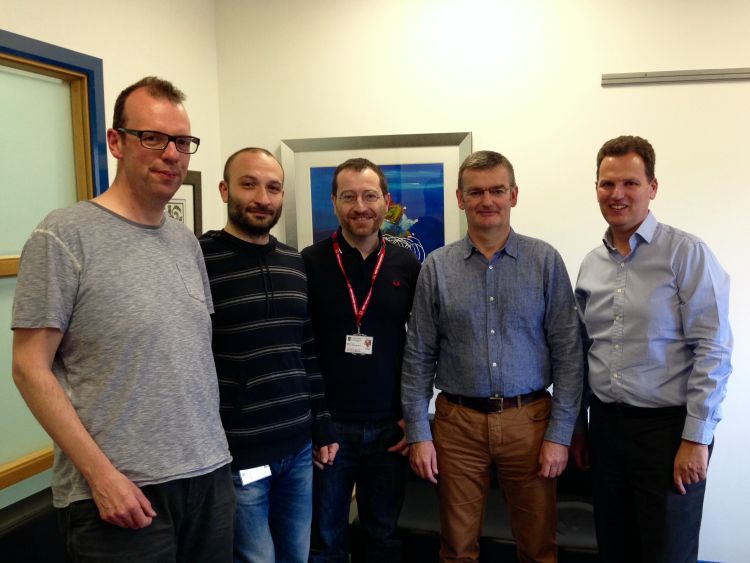Body fights clogged arteries with localised immune response
Published: 29 June 2015
Scientists have discovered an immune response in an animal model that appears to provide protection against clogged arteries – atherosclerosis.
Scientists have discovered an immune response in an animal model that appears to provide protection against clogged arteries – atherosclerosis.
Atherosclerosis is caused by the gradual hardening and narrowing of blood vessels due to the build-up of ‘bad’ cholesterol deposits inside the vessel walls.
This build-up provokes an immune response but the white blood cells sent to the scene to fight the cholesterol combine with the invaders to inflame the vessel walls and form a plaque narrowing the artery.
The condition can go unnoticed and be trouble-free for years, until the narrowing becomes too great and damages organs or a piece of the plaque, having been degraded by immune cells, breaks off and is carried in the blood stream where it blocks smaller vessels, resulting in ischaemic stroke or heart attack.
While the reasons for the build-up of plaques in vessel walls are not fully understood, the process begins from an early age and is thought to be a natural part of ageing.
Poor diet, smoking, hypertension, diabetes and obesity can accelerate atherosclerosis but increasingly researchers have been scrutinising the role the systemic immune response plays in exacerbating the condition.
The latest study published in the journal Immunity, led by Ludwig-Maximilians-University of Munich academics in collaboration with the University of Glasgow, found that during ageing, immune cells infiltrate the blood vessel walls and form tertiary lymphoid organs (TLOs) next to plaque sites that appear to protect against atherosclerosis.
TLOs are similar to other lymph organs such as the tonsils, spleen and lymph nodes – key elements in the immune system. But unlike these organs, which develop at specific locations in the embryo during gestation in the womb, TLOs develop during adult life in response to chronic inflammation.
Until now the role of TLOs has not been determined and it has not been clear if they provide a beneficial or negative effect at sites of inflammation.

Professor Andreas Habenicht of Ludwig-Maximilians-University, Munich, said: “The impact of TLOs in any disease setting has been an important yet unanswered question in the immunology of unresolving inflammation. Our study suggests the TLOs seem to provide protection from advanced atherosclerosis.
“The aging immune system assembles and selectively employs a TLO within diseased peripheral tissue to control immune responses while bypassing the secondary lymphoid organs including the spleen and lymph nodes.
“Thus artery TLOs are instrumental to understanding adaptive immunity in advanced atherosclerosis and possibly other chronic inflammatory diseases and key to identifying new targets for therapeutic intervention.”
Doctor Pasquale Maffia of the Institute of Infection, Immunity and Inflammation at the University of Glasgow, said: “If we can translate our findings to humans it would change the way we treat this condition in the advanced stages.
“Most interventions for atherosclerosis are preventative – encouraging people to eat a better diet, exercise and reduce their smoking habit. There is very little that can be done once plaque has built up.
“Current research focuses on systemic immune response, but we have identified a site-specific target for interventions. Our data suggests we should target the immune response locally in the TLOs, and not systemically as atherosclerosis appears to be a vascular immune disease, not a systemic one.
“We should target the balance between athero-protective and athero-promoting cells generated in the TLOs to develop fundamentally new therapeutic strategies, including preventative approaches such as immunotherapeutics.”
Professor Jeremy Pearson, Associate Medical Director at the British Heart Foundation, which helped fund the research, said: “This research, in mice, provides important new information about how the immune response to protect against atherosclerosis is tightly orchestrated by collections of immune cells called tertiary lymphoid organs close to the artery wall. If similar processes can be identified in people, these results have the potential to lead to new life saving treatments and changes in clinical practice to help prevent heart attacks and strokes.”
The work was supported by the German Research Council, the German Centre for Cardiovascular Research, the British Heart Foundation, the European Research Council and Medical Research Scotland.
Notes to Editors
Link to article: http://www.cell.com/immunity/abstract/S1074-7613(15)00213-7
This study involved the use of animals, specifically mice. For more information about our policy on using animals in research visit: http://www.gla.ac.uk/research/aims/ourpolicies/opennessinanimalresearch/
Related links
- Dr Pasquale Maffia: researcher profile
- Immunobiology research at the University of Glasgow
- BSc (Hons) Immunology
- MSc Immunology & Inflammatory Disease
Media enquiries: stuart.forsyth@glasgow.ac.uk / 0141 330 4831
First published: 29 June 2015
<< June

